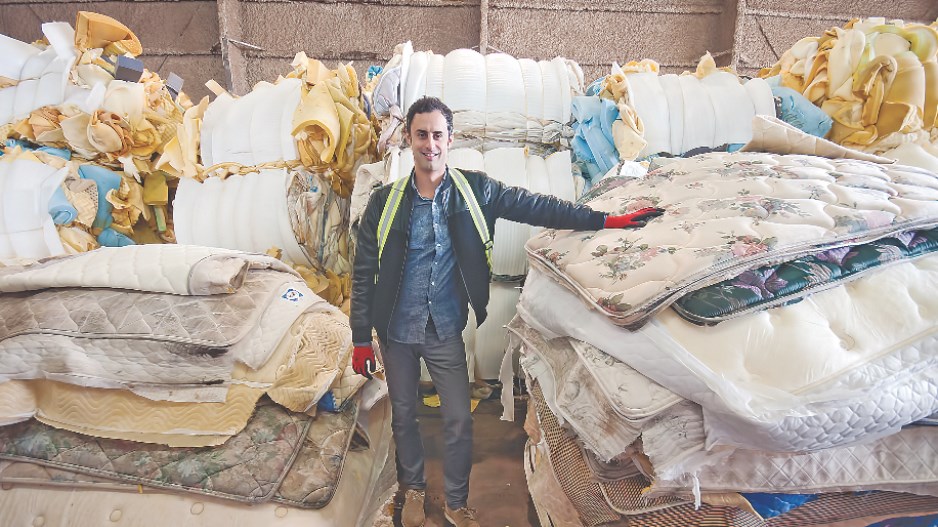For Mattress Recycling, calling the past couple of years ‘challenging’ would be an understatement. In May 2015, a fire destroyed the recycling company’s facility in south Vancouver. Then, almost exactly two years later, another fire decimated their Richmond plant.
“It’s been the most difficult thing that I’ve ever been through. The challenges were extreme in every aspect,” said CEO Fabio Scaldaferri, who co-founded the company in 2008.
But now the recycling firm, the largest of its kind in Western Canada, has sprung back with a state-of-the-art facility in Hope, B.C. and an expanded suite of recycling services and partnerships.
After an estimated $3.5-million investment, Scaldaferri says the new facility is much more appropriate to their needs, with previous challenges partly a function of the industrial landscape of Metro Vancouver.
“It was not very industry-friendly, especially for a small company like mine,” he said, adding that facilities in the area are often scarce and ill-suited for recycling operations. “In the end, you’re just leasing facilities that are super inappropriate for the type of business that we run. And recycling is a pretty unique thing. You need certain things and you generally can’t find them.”
The company has now set up shop in a new purpose-built facility, with easy access to the Trans-Canada Highway. “We addressed one major problem which was our bottleneck for transportation. We used to have basically no proper loading bays and now we have 22 dock loading bays,” he said.
Mattress Recycling’s name is still a good indicator of the company’s primary business. Since 2008, the company has processed more than 650,000 mattresses, with Scaldaferri estimating the new facility is processing at a rate of 70,000-90,000 units per year.
But the company now also accepts bulky furniture such as futons, couches, armchairs and child car seats, as well as clothing, shoes and even some electronic appliances and devices.
Mattresses and furniture are reduced to their components, such as foam, metal and quilting. These component materials are then sold to other companies to be refashioned into other products, such as carpet underlay. Scaldaferri estimates that around 60% of a mattress’s materials gets processed for remanufacturing.
To further reduce landfill use, most of the remaining 40% is now sold to concrete companies as alternative fuel, which is used instead of natural gas to reduce carbon emissions.
Lafarge Canada Inc.’s Richmond plant is an example of this kind of partnership. The plant’s lower carbon fuel (LCF) system is projected to replace 50% of its fossil fuel consumption with alternative fuel materials like those provided by Mattress Recycling, which will result in a 20% reduction in combustion emissions.
Pascal Bouchard, the manager of Lafarge’s Richmond plant, said that partnering with companies like Mattress Recycling is “crucial to the success of this project.” “We’re a solution to some of their challenges and they’re a solution for us to reduce our carbon footprint.”
Aside from benefiting from industry partnerships, Mattress Recycling has also benefited from increasingly strict environmental regulation.
When Metro Vancouver banned mattresses and box springs from the region’s landfills in 2011 and imposed a $15 recycling fee, business jumped. Between 2011 and 2016, the company went from recycling 3,000 mattresses per year to 120,000 – a 3,900% increase.
But Scaldaferri says work remains to be done in this area, with the next step being a provincial extended producer responsibility (EPR) program for mattresses and other bulky furniture items.
Under an EPR, manufacturers are given responsibility for the treatment or disposal of their products, often passing on those costs to consumers at the point of purchase as opposed to municipalities charging a fee for recycling at the end of the product’s lifespan.
“[An EPR program for mattresses] is really important for municipalities to reduce their expenses and then put the cost of the recycling on the consumer at the point of purchase,” Scaldaferri said.
“Not only will it take millions of dollars of expenses away from municipalities, where they can spend it on other things, but it will also increase the amount of total recycling that will happen in British Columbia. Because right now, apart from Metro Vancouver, the rest of B.C. is not obliged to recycle mattresses.”




